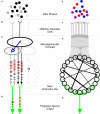Innate recognition of pheromone and food odors in moths: a common mechanism in the antennal lobe?
- PMID: 20953251
- PMCID: PMC2955495
- DOI: 10.3389/fnbeh.2010.00159
Innate recognition of pheromone and food odors in moths: a common mechanism in the antennal lobe?
Abstract
The survival of an animal often depends on an innate response to a particular sensory stimulus. For an adult male moth, two categories of odors are innately attractive: pheromone released by conspecific females, and the floral scents of certain, often co-evolved, plants. These odors consist of multiple volatiles in characteristic mixtures. Here, we review evidence that both categories of odors are processed as sensory objects, and we suggest a mechanism in the primary olfactory center, the antennal lobe (AL), that encodes the configuration of these mixtures and may underlie recognition of innately attractive odors. In the pheromone system, mixtures of two or three volatiles elicit upwind flight. Peripheral changes are associated with behavioral changes in speciation, and suggest the existence of a pattern recognition mechanism for pheromone mixtures in the AL. Moths are similarly innately attracted to certain floral scents. Though floral scents consist of multiple volatiles that activate a broad array of receptor neurons, only a smaller subset, numerically comparable to pheromone mixtures, is necessary and sufficient to elicit behavior. Both pheromone and floral scent mixtures that produce attraction to the odor source elicit synchronous action potentials in particular populations of output (projection) neurons (PNs) in the AL. We propose a model in which the synchronous output of a population of PNs encodes the configuration of an innately attractive mixture, and thus comprises an innate mechanism for releasing odor-tracking behavior. The particular example of olfaction in moths may inform the general question of how sensory objects trigger innate responses.
Keywords: floral scent; moths; neuroethology; olfaction; pheromone; sensory coding; sensory object; synchrony.
Figures

Similar articles
-
Differential interactions of sex pheromone and plant odour in the olfactory pathway of a male moth.PLoS One. 2012;7(3):e33159. doi: 10.1371/journal.pone.0033159. Epub 2012 Mar 12. PLoS One. 2012. PMID: 22427979 Free PMC article.
-
Pheromone modulates plant odor responses in the antennal lobe of a moth.Chem Senses. 2014 Jun;39(5):451-63. doi: 10.1093/chemse/bju017. Epub 2014 May 5. Chem Senses. 2014. PMID: 24798893
-
Male-specific, sex pheromone-selective projection neurons in the antennal lobes of the moth Manduca sexta.J Comp Physiol A. 1987 May;160(5):553-69. doi: 10.1007/BF00611929. J Comp Physiol A. 1987. PMID: 3612589
-
The Synthetic Moth: A Neuromorphic Approach toward Artificial Olfaction in Robots.In: Persaud KC, Marco S, Gutiérrez-Gálvez A, editors. Neuromorphic Olfaction. Boca Raton (FL): CRC Press/Taylor & Francis; 2013. Chapter 4. In: Persaud KC, Marco S, Gutiérrez-Gálvez A, editors. Neuromorphic Olfaction. Boca Raton (FL): CRC Press/Taylor & Francis; 2013. Chapter 4. PMID: 26042327 Free Books & Documents. Review.
-
Pheromones and General Odor Perception in Insects.In: Mucignat-Caretta C, editor. Neurobiology of Chemical Communication. Boca Raton (FL): CRC Press/Taylor & Francis; 2014. Chapter 2. In: Mucignat-Caretta C, editor. Neurobiology of Chemical Communication. Boca Raton (FL): CRC Press/Taylor & Francis; 2014. Chapter 2. PMID: 24830044 Free Books & Documents. Review.
Cited by
-
Innate and learned components of egg recognition in the ant Camponotus floridanus.R Soc Open Sci. 2024 Jun 26;11(6):231837. doi: 10.1098/rsos.231837. eCollection 2024 Jun. R Soc Open Sci. 2024. PMID: 39100179 Free PMC article.
-
Rapid processing of chemosensor transients in a neuromorphic implementation of the insect macroglomerular complex.Front Neurosci. 2013 Jul 12;7:119. doi: 10.3389/fnins.2013.00119. eCollection 2013. Front Neurosci. 2013. PMID: 23874265 Free PMC article.
-
Insect chemoreception: a tribute to John G. Hildebrand.J Comp Physiol A Neuroethol Sens Neural Behav Physiol. 2013 Nov;199(11):875-7. doi: 10.1007/s00359-013-0857-z. Epub 2013 Oct 10. J Comp Physiol A Neuroethol Sens Neural Behav Physiol. 2013. PMID: 24114616 No abstract available.
-
Olfactory coding in honeybees.Cell Tissue Res. 2021 Jan;383(1):35-58. doi: 10.1007/s00441-020-03385-5. Epub 2021 Jan 14. Cell Tissue Res. 2021. PMID: 33443623 Free PMC article. Review.
-
Friends and foes from an ant brain's point of view--neuronal correlates of colony odors in a social insect.PLoS One. 2011;6(6):e21383. doi: 10.1371/journal.pone.0021383. Epub 2011 Jun 23. PLoS One. 2011. PMID: 21731724 Free PMC article.
References
-
- Anglade P., Stockel J. (1984). Intraspecific sex pheromone variability in the European corn borer, Ostrinia nubilalis Hbn. (Lepidoptea, Pyralidae). Agronomie 4, 183–18710.1051/agro:19840209 - DOI
-
- Anton S., Homberg U. (1999). “Antennal lobe structure,” in Insect Olfaction, ed.Hansson B. S.(Heidelberg: Springer; ), 98–125
Grants and funding
LinkOut - more resources
Full Text Sources

